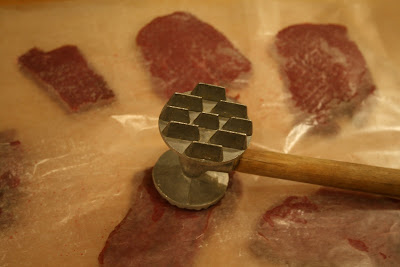Venison Stock
Since my dear hubby went hunting and brought home a lovely deer, we've been busy butchering it up. Justin usually does the most basic cleaning out in the field. He guts and skins it before it comes home. Sometimes, he keeps the animal whole. If the weather is too warm, he quarters it and brings it home in coolers with ice.
We usually cut it all down into steaks, stew, and jerky meat right away. I asked him to make some big roasts this year. I have some plans that involve making some pretty fancy British venison dishes. They mostly call for venison stock or demiglaze to complete the sauces. Here was my chance to make some stock, too.
I made sure he saved me a bunch of good bones. I used the leg bones and part of the pelvis. We sawed them into pieces with the reciprocating saw, and I got busy cooking before the marrow had a chance to get weird.
Now I have some beautiful stock ready for action!
PS. This recipe will also work for other red meat animals if you don't want or don't have access to wild game.
Ingredients
about 5 lbs deer bones, sawn into about 3" lengths
2 yellow onions, coarsely chopped
4 medium carrots, coarsely chopped
3 celery stalks, coarsely chopped
3-5 large cloves garlic, peeled, whole, smashed
3 bay leaves
1/2 Tablespoon whole black peppercorns
6 springs Italian parsley, whole
1 1/2 cups red wine, I used Pinot Noir
water, about 4 quarts for an 8 Qt. pot
Method
1. Brown the bones in the oven, 400F for 30-45 minutes.
2. Transfer bones to your stock pot, about 8 Qt. size. Use about 2 cups water to deglaze the baking pan. Pour that into the stock pot. Add all the other ingredients. Fill with water up to about 1" below the rim of the pot.
3. Bring to a boil, then reduce heat to let it simmer, covered, about 3 hours.
4. Remove the pot from the heat and allow to cool a few minutes. Using a slotted spoon, remove the bones and vegetable solids. I like to set them in a strainer over a bowl to collect any liquid that may drip off.
5. Using a large mesh strainer, pour the stock into a smaller pot or mixing bowl. Discard any solids left in the strainer.
6. Strain the stock again using a fine mesh strainer or finely woven cloth.
7. Allow the stock to cool completely. I usually let mine chill in the fridge overnight, or outside on the back porch if it's cold enough and the fridge is full. When cold, remove the layer of solidified fat and if there are solidified droplets, strain those out as well.
8. Divide up your stock into portions.Place in a freezer-safe container. Label it and freeze until you're ready to use. I divided mine up into 1-cup, 2-cup, and 3-cup portions. I got just shy of 3 quarts of stock from this batch. If you have a deep freeze, this stock will be good for at least a year.
We usually cut it all down into steaks, stew, and jerky meat right away. I asked him to make some big roasts this year. I have some plans that involve making some pretty fancy British venison dishes. They mostly call for venison stock or demiglaze to complete the sauces. Here was my chance to make some stock, too.
I made sure he saved me a bunch of good bones. I used the leg bones and part of the pelvis. We sawed them into pieces with the reciprocating saw, and I got busy cooking before the marrow had a chance to get weird.
Now I have some beautiful stock ready for action!
PS. This recipe will also work for other red meat animals if you don't want or don't have access to wild game.
Ingredients
about 5 lbs deer bones, sawn into about 3" lengths
2 yellow onions, coarsely chopped
4 medium carrots, coarsely chopped
3 celery stalks, coarsely chopped
3-5 large cloves garlic, peeled, whole, smashed
3 bay leaves
1/2 Tablespoon whole black peppercorns
6 springs Italian parsley, whole
1 1/2 cups red wine, I used Pinot Noir
water, about 4 quarts for an 8 Qt. pot
Method
1. Brown the bones in the oven, 400F for 30-45 minutes.
2. Transfer bones to your stock pot, about 8 Qt. size. Use about 2 cups water to deglaze the baking pan. Pour that into the stock pot. Add all the other ingredients. Fill with water up to about 1" below the rim of the pot.
3. Bring to a boil, then reduce heat to let it simmer, covered, about 3 hours.
4. Remove the pot from the heat and allow to cool a few minutes. Using a slotted spoon, remove the bones and vegetable solids. I like to set them in a strainer over a bowl to collect any liquid that may drip off.
5. Using a large mesh strainer, pour the stock into a smaller pot or mixing bowl. Discard any solids left in the strainer.
6. Strain the stock again using a fine mesh strainer or finely woven cloth.
7. Allow the stock to cool completely. I usually let mine chill in the fridge overnight, or outside on the back porch if it's cold enough and the fridge is full. When cold, remove the layer of solidified fat and if there are solidified droplets, strain those out as well.
8. Divide up your stock into portions.Place in a freezer-safe container. Label it and freeze until you're ready to use. I divided mine up into 1-cup, 2-cup, and 3-cup portions. I got just shy of 3 quarts of stock from this batch. If you have a deep freeze, this stock will be good for at least a year.











Comments
Post a Comment